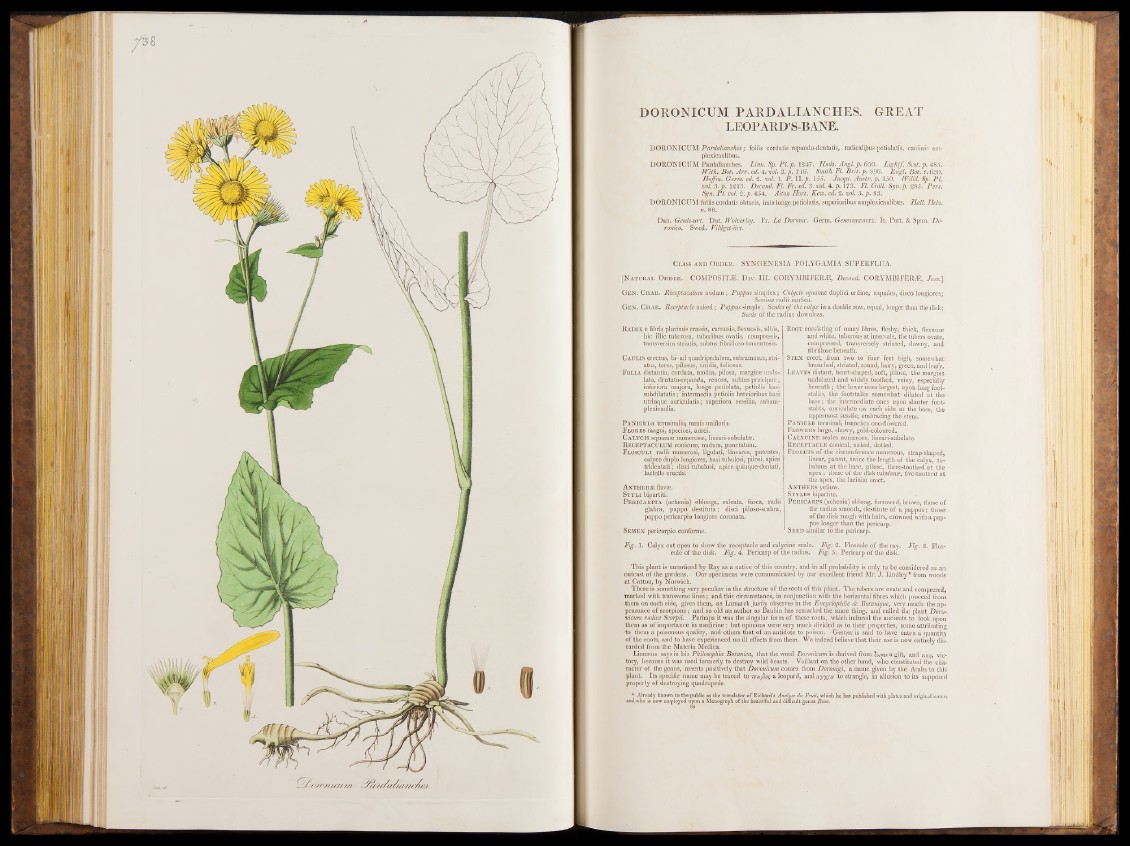
DORONICUM PARDALIANCHES. GREAT
LEOPARD’S-BANE.
DORO N ICUM Pardalianch.es ; foliis 'cordatis repando-dentatis, radicalisms petiolatis, caulinis am-
plexicaulibus.
DORONICUM Pardalianches. Linn. Sp. P l .p . 1247. Hiids. An g l.p . 650.- Lig h tf. Scot. p. 485. •
■With. Bot. A r r . ed. 4. Vol. 3. p. 716. Smith Fl. B r it. p. 896. Engl. Bot. t. 630.
Hqffm. Germ. ed. 2. ml. 1. P . II. p . 155. Jacqu. A u s tr .p . 350. Willd. Sp. PI.
•col. 3. p. 1213. Decand. Fl. Fr. ed. 3. ml. 4. p. 173. Fl. Gall. Syn.p. 285. Pers.
Syn. PI. ml. 2. p. 454. A it on Hort. Kern. ed. 2. ml. 5. p. 83.
DORO N ICUM foliis cordatis obtusis, irais longe petiolatis, superioribus amplexicaulibus. Hall. Helv.
n. 88.
Dan. Geede-urt. Dut. Woherley. Fr. L a Doronic. Germ. Genesenwurtz. It. Port. & Span. Do-
ronico. Swed» Vildget-ört.
Class a n d Order. SYNGENESIA POLYGAMIA SUPERFLUA.
[N atural Ord e r . COMPOSITIE. D iv . I I I . CORYMBIFERjE, Decand. CORYMBIFERyË,
Gen . Char. Réceptaculum nudum; Pappus simplex; Calycis squamoe duplici ordine, tequales) disco longiores;
Semina radii mudca.
Gen . Char. Receptacle naked; Pappus simple; Scales o f the calyx in a double row, equal, longer than the disk;
Seeds of the radius downless.
Radix e fibris plurimis crassis, carnosis, flexuosis, albis,
hie illic tuberosa, tuberibus ovatis, compressis,
transversim striatis, subtus fibrilloso-tomentosis.
Caulis erectus, bi-ad quadripedalem,subramosus, stri-
atus, teres, pilosus, viridis, foliosus.
Folia distanda, cordata, mollia, pilosa, margine undu-
lata, dentato-repanda, venosa, subtus prajeipue;
inferiora majora, longe petiolata, petiolis basi
subdilatatis; intermedia petiolis brevioribus basi 1
utrinque auriculatis; superiora sessilia, subam-
plexicaulia.
Panicula terminalis, ramis unifloris.
F lores magni, speciosi, aurei.
Calycis squamae numerosae, lineari-subulatae.
R eceptaculum conicum, nudum, punctatum.
Flosculi radii numerosi, ligulati, lineares, patentes,
calyce duplo longiores, basi tubulosi, pilosi, apice
tridentati; disci tubulosi, apice quinque-dentati,
laciniis erectis.
Anther® flavaj.
Styli bipartiti.
Pericarpia • (achenia) oblonga, sulcata, fusca, radii
glabra, pappo destituta; disci piloso-scabra,
pappo pericarpio longiore coronata.
Semen pericarpio conforme.
ROOT consisting of many fibres, fleshy) thick, flexuose
and white, tuberous at intervals, the tubers ovate,
compressed, transversely striated, downy, and
fibrillose beneath.
Stem erect, from two to four feet high, somewhat
branched, striated, round, hairy, green, and leafv.
Leaves distant, heart-shaped, soft, pilose, the margins
undulated and widely toothed, veiny, especially
beneath; the lower ones largest, upon long footstalks,
the footstalks somewhat dilated at the
base; the intermediate ones upon shorter footstalks,
auriculate on each side at the base, the
uppermost sessile, embracing the stem.
Panicle terminal, branches one-flowered.
Flowers large, showy, gold-coloured.
Calycine scales numerous, lineari-subulate.
Receptacle conical, naked, dotted.
Florets of the circumference numerous, strap-shaped,
linear, patent, twice the length of the calyx, tu-
bulous at the base, pilose, three-toothed at the
apex; those of the disk tubulous, five-toothed at
the apex, the lacinite erect.
Anthers yellow.
Styles bipartite.
Pericarps (achenia) oblong, furrowed, brown, those of
the radius smooth, destitute of a pappus; those
of the disk rough with hairs, crowned with a pappus
longer than the pericarp.
Seed similar to the pericarp.
Fig. 1. Calyx cut open to show the receptacle and calycine scale. Fig. 2. Floscule of the ray. Fig. 3. Flos-
cule of the disk. Fig. 4. Pericarp of the radius. Fig. 5. Pericarp of the disk.
This plant is unnoticed by Ray as a native of this country, and in all probability is only to be considered as an
outcast of the gardens. Our specimens were communicated by our excellent friend Mr. J . Lindley* from woods
at Catton, by Norwich.
There is something very peculiar in the structure of the roots of this plant. The tubers are ovate and compresed,
marked with transverse lines; and this circumstance, in conjunction with the horizontal fibres which proceed from
them on each side, gives them, as Lamarck justly observes in the Encyclopédie de Botanique, very much the appearance
of scorpions ; and so old an author as JBauhin has remarked the same thing, and called the plant Doro-
nicum radice Scorpii. Perhaps it was the singular form of these roots, which induced the ancients to look upon
them as of importance in medicine : but opinions were very much divided as to their properties, some attributing
-to them a poisonous quality, and others that o f an antidote to poison. Gesner is said to have eaten a quantity
o f the roots, and to have experienced no ill effects from them. We indeed believe that their use is now entirely discarded
from the Materia Medica.
Linnæus says in his Philosophia Botanica, that the word Doronicum is derived from $woov a gift, and vtx 17, victory,
because it was used formerly to destroy wild beasts. Vaillant on the other hand, who constituted the character
of the genus, asserts positively that Doronicum comes from Doronigi, a name given by the Arabs to this
plant. Its specific name may be traced to •arap$oç a leopard, and ayxjuv to strangle, in allusion to its supposed
property of destroying quadrupeds.
* Already known to the public as the translator of Richard’s Analyse du Fruit, which he has published with plates and original notes;
and who is now employed upon a Monograph of the beautiful and difficult genus Rosa.
f l